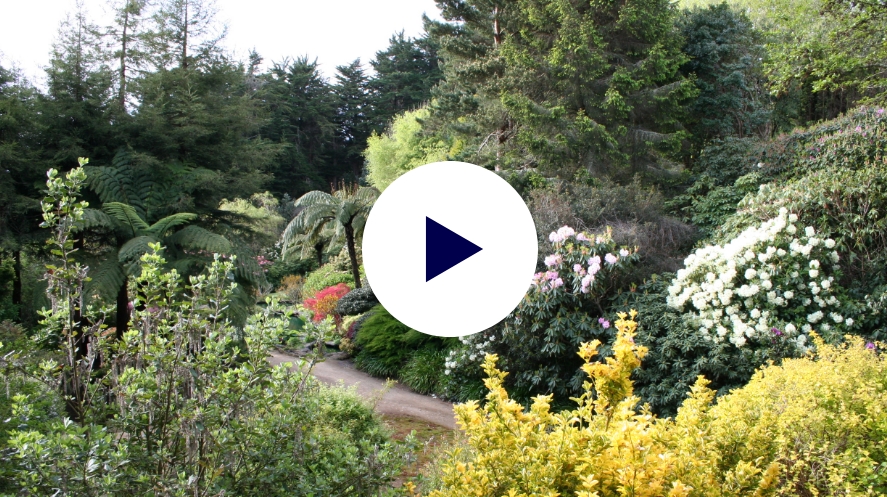Always plant rhododendrons and azaleas so the soil level just covers the top of the rootball. Rhododendrons and azaleas are fibrous rooting and have no ability to penetrate most subsoils, so are naturally shallow rooting. Dig a planting hole 30cm wider each side of any plant rootball and 40cm deep, regardless of soil type. If soil is heavy, throw awaymost of the subsoil and make up the difference with material as mentioned earlier under Soils and then mix this in with the topsoil. Mix one teacup of acid fertiliser with the soil that goes back into the hole. Firm plant just enough to gain good contact with root ball, never tramp in too hard. If planting on a slope, the pinning of a log or ponga on the bottom side will provide a flat area on which to plant and will hold moisture as well as a mulch.

After planting, mulching with coarse organic matter (not lawn clippings) will help conserve moisture and provide a cool root run, at the same time controlling weeds. Heaping mulches up around the trunk is not recommended, as it inhibits light rain penetrating through to the roots. Mushroom Compost !! We do not recommend the use of Mushroom Compost, either as a mulch or incorporating it into the planting hole due to the high pH of this product. Do not cultivate around rhododendrons and azaleas, especially in the summer. In some circumstances, if the surface roots of rhododendrons are damaged during periods of active growth and high soil temperatures, the phytophthora organism could invade the root tissue. The fungus can develop quickly killing the tissue and consequently the plant.
Water carefully during dry weather especially during the first three summers after planting. It is better to wet the soil deeply each time and water less frequently. If a plant shows signs of distress e.g. curled or droopy leaves after watering, dig down and check that the root ball is wet and making good contact with surrounding soil. Under watering or severe dryness will show up as brown tips to leaves in the Autumn – Winter period. (Drooping of leaves during the winter is quite normal – it is due to the cold weather).
Hot summers create stress not only for animals but for our plants too. Rhododendrons and azaleas constantly lose water by transpiration through their leaves. Old established plants can survive periods of drought in the late summer because they are no longer in active growth. Leaves may wilt and curl during the day causing the plants to look stressed, but no damage results, so long as the leaves are turgid again by morning. If they are still curled or wilted in the morning action is needed e.g. a good soaking. Curling of the leaves is natures way of reducing the surface area of the leaf from which transpiration can occur. A water stressed plant is more susceptible to disease, insect attack and dieback. Young plants in their first three years in your garden must be a priority in your watering schedule. Mulching is always beneficial
Your garden soil, whatever its condition, contains organic matter. Tests show that dry organic matter actually repels water and is difficult to re wet. In pot plants, tubs and hanging baskets the problem can be severe due to rapid evaporation of moisture. Pot and Soil Wetter is the product that saves plants, saves water and saves time. Liquid soil wetters act in a similar way to detergents. They break the surface tension and encourage water to penetrate into the area where they’ve been applied.
This is particularly important when soil has dried out because dry soil can be quite water-repellent (you know how hard it is to wet dusty soil). Potting mix is even worse it’s based on organic matter (composted pine bark or sawdust) and, as the organic matter ages, it can build up a waxy external coating that becomes increasingly difficult to wet. Often water just runs down between the sides of the pot and the mix instead of entering the root area. Pot and Soil Wetter has an added soil conditioner to soften soil so that physical barriers to water penetration are reduced.
Another good suggestion for using soil wetters is applying after planting and transplanting when water finds it easier to move into the soft soil in the surrounding area rather than into an established root system. By applying Pot and Soil Wetter directly to the root area, water is able to get into the roots where it’s needed.
Available in 500ml Concentrate. Please scroll through our garden products and add your Pot and Soil Wetter requirements to your plant order.


Garden
365 Days
Nursery & Plant Centre
7 Days a week from Monday 9th June 2025 - 1st December 2025
10.30am - 5pm
Garden Café
Catering is available for pre-booked groups only, subject to availability, please contact our office to discuss.
339 Rangiwahia Road
RD 54
Kimbolton 4774
New Zealand
P. 06 328 5797
E. office@crosshills.co.nz

Solution by Webtech